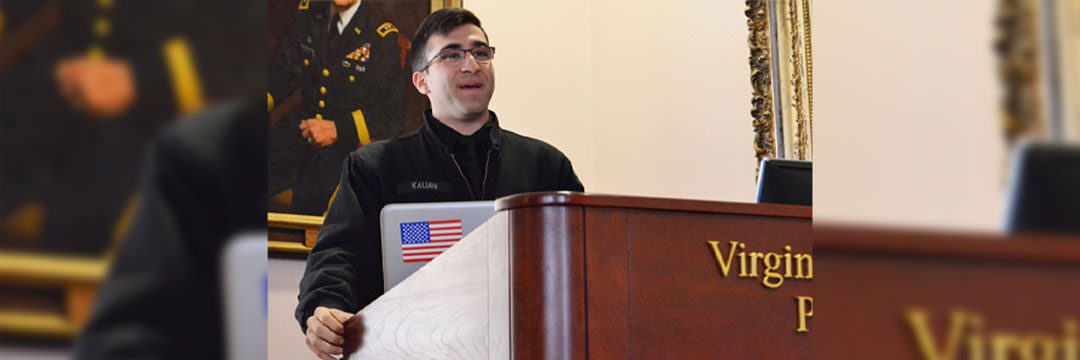‘Dykelopedia’ Cadet Project Seeks to Create Searchable Database of Rat/Dyke Relationships

Kirk Kalian ’19 discusses his Institute Honors project “Dykelopedia” during Honors Week. VMI photo by Mary Price.

Kirk Kalian ’19 discusses his Institute Honors project “Dykelopedia” during Honors Week. VMI photo by Mary Price.
The internet has now been around long enough that doing genealogical research online has become commonplace. But what if VMI relationships were as easy to trace as those between ancestors and descendants?
During his 4th class year, Kirk Kalian ’19 hit upon an idea that he’s been pursuing ever since: creating a searchable database, available online, of the “dyke line” that binds together cadets that are three class years apart, as each 4th Class cadet is assigned a 1st Class cadet as a “dyke,” or mentor. Cadets that are six class years apart are in the same dyke line.
Kalian, a computer and information science major, took his idea and developed it into a workable prototype for his Institute Honors project, titling his work, “Dykelopedia: VMI’s Dykeline Digitized.”
The dyke line “creates a special bond that’s unique to VMI,” Kalian commented during his Honors Week presentation in the Turman Room of Preston Library. Knowing one’s dyke line “would be a great con-versation starter and increase your networking capability as a cadet,” he stated.
Agreeing with Kalian’s assessment was his adviser, Dr. Ramoni Lasisi, assistant professor of computer and information sciences. “This is VMI history – the kind of thing that many cadets would like to see,” he commented.
Initially, Kalian had hoped to be able to trace dyke lines all the way back to 1974, which is when VMI began keeping track of rat/dyke relationships. Reality set in, though, as the laborious nature of the process took a toll on Kalian’s time available for the project. By mid-March, he’d only been able to go back as far as 2003, although he was planning to keep working on the project until graduation.
Another hurdle Kalian had to overcome was inaccuracies in his source material, specifically The Bomb, VMI’s yearbook. Because of this, his database currently has an accuracy rate of 88 percent for three generations or greater – a figure that Kalian would very much like to see improved.
The accuracy rate “needs to be much higher than that to be trusted,” Lasisi confirmed. He stated that an accuracy rate in the mid-90s or higher would be ideal.
At his honors thesis presentation, Kalian was able to demonstrate his database for cadets in the audience, with good results. But he hasn’t been able to come up with an online version accessible to anyone interested. That’s a goal, but privacy concerns are something he’s yet to address, and he’s also aware that his creation has some weaknesses, such as not being able to adjust for dyke lines that are not exactly three years apart, as they might be in the case of a dyke who is taking a fifth year to complete his or her education.
Going forward, Kalian would like to pass his project off to another cadet who might complete it as a capstone project. “This is something I’m passionate about,” he noted.
